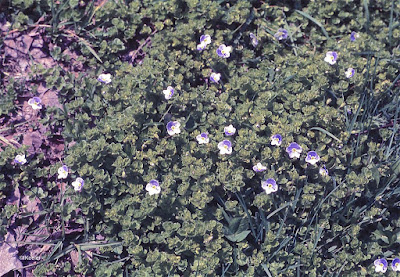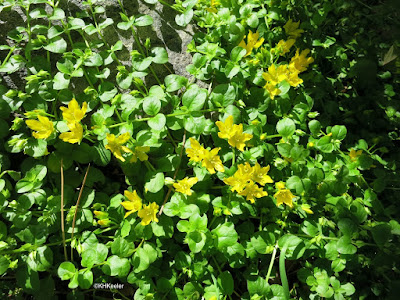 |
| Do you call this Louisiana sagewort or white sage or... (Artemisia ludoviciana) |
When I was a teen (1960s) my mother found a new plant growing in the lawn of our northern Ohio home. She didn't know it, didn't have a name for it, neither did her neighbors and her garden books did not include it. She tried a couple names, from "that weed" and "blue-flowered creeper" to "creeping Charley," finally settling on "creeping Jenny."
 |
| What Mom called "Creeping Jenny" |
 |
| Lysmachia nummularia, creeping Jenny |
 |
| usually called field bindweed, Convovulus arvensis is another creeping Jenny |
When we encounter plants we don't know, we ask the people we are with for a name. Consequently we transmit local, often non-standard names.
I suppose a study which looked at which names are remembered would show curious patterns, based on an association with something the listener knew. When I say this plant is called henfat, lambsquarters, and goosefoot, which will be remembered?
 |
| Called henfat, lambsquarters and goosefoot (Chenopodium album) |
Furthermore, the study of words is full of people revising the words to make them easier to pronounce, seem more logical, or "sound better." Of course it applies to plant names. We call an American sunflower, Helianthus tuberosus, Jerusalem artichoke. (photos: Wikipedia) "Jerusalem"? "artichoke?" The first known report was by French explorer Samuel de Champlain (biography) who saw them cultivated in Massachusetts in 1605 and compared the taste to artichokes. But the Jerusalem has two explanations: the common one is that they were called girasole articiocco ("sunflower artichoke," in Italian) by immigrants and girasole was heard as "Jerusalem" by English speakers. That story has the problem that it was called Jerusalem artichokein print in English by 1621. The Plymouth Colony founded 1620, so too early for Italian immigrants to North America. (Though I can't say the plant didn't go to Italy before being introduced to England along with an Italian name.) Jerusalem artichokes spread quickly across Europe from Champlain's introduction to Europe, and possibly other early explorers brought it back too. Sunflower expert C. B. Heiser was satisfied with the explanation that "Jerusalem" was a corruption of Ter Neusen (Terneuzen, Holland), the place from which Jerusalem artichokes were first introduced to England. Either way, the common name evolved from exotic words to the more familiar "Jerusalem."
Well before that, tomatoes (Solanum lycopersicum) were introduced to Europe from the New World. The Spanish called them pomi di mori, apple of the Moors, because they confused them with eggplants (aubergines, Solanum melongena) which were also new then (early 1500s) and had come from Asia via the Arabs. However, when the Spanish merchant said pomi di mori, Frenchmen heard pom d'amour, love apple, while Italians heard pomodoro, golden apple, giving the plant some pretty odd common names.
 |
| pomodoro, golden apple (Solanum lycopersicum) |
Where it gets weird is as we merge into a single community on the internet. I write on the internet. To write about plants, I have to use a name. But there are so many choices! Even when I go to "authorities"-- books published by groups of experts or websites maintained by organizations like the United States Department of Agriculture--I find many plants for which each authority has published a different common name.
I think it would be VERY helpful if the authorities agreed on a single common name, at least within a country.
Oh. Right. Authorities agree?
Not likely.
The scientific name, only one per species, was the solution--created 400 years ago!--to the problem of multiple names for plants. Even if you don't like them, getting the scientific name for the plant of interest is the only truly effective way to check which plant it is.
If you are writing for the internet, please include the scientific name, just once.
As for what common name to use, especially at home, pick one or, even, make up your own.
 |
| Common names: common mullein, Aaron's rod, Quaker rouge and many more (Verbascum thapsus) |
Note: Wikipedia (link) says Levetin and McMahon, in Plants and Society (2012), which I haven't seen, say the Pilgrim's called it Jerusalem artichoke, meaning the America was (new) Jerusalem. The timing does not does not work for Plymouth Colony, however: see Gerard's herbal, link below.
References
Gerard, John. 1636 edition. The Herbal or General Historie of Plantes. Chap. 260 Of Jerusalem Artichoke. pp. 752-754 quotes a letter from John Goodyer in 1621 and makes the plant sound widely grown. link
Heiser, C. B., Jr. 1995. Sunflowers Helianthus (Compositae) pp. 51-53 in J. Smart and N. W. Simmonds, Evolution of Crop Plants. 2nd edition. Longman Scientific and Technical, London.
see also my previous blogs on these plants
Kathy Keeler, A Wandering Botanist
More at awanderingbotanist.com
Related blog posts
Hen fat: Chenopodium album link
Lousiana sagewort (Artemisia ludoviciana) link
Mullein: Common mullein and its folklore link
Tomato: The Rise of the Tomato link and Tomato the Vegetable (link)
No comments:
Post a Comment